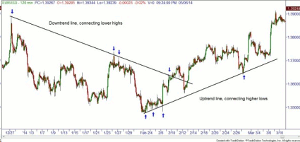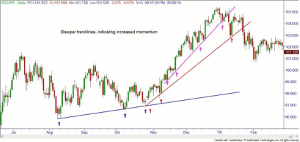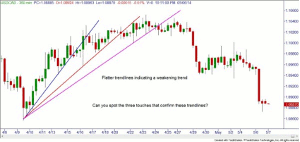Forex trading instructor, Rick Wright of Online Trading Academy, offers a couple of techniques for using trend lines to help you determine the strength or weakness of a trend.
As you have probably noticed from reading our weekly Lessons from the Pros newsletters, our core strategy includes going long in up trends at high quality demand zones, and going short in downtrends in high-quality supply zones. A few significant stumbling blocks that new traders encounter is defining the trend that they are in, if that trend still has room to run, or if the trend is getting ready to end. While no trend definition technique is truly infallible, proper use of trend lines can help keep you on the right side of the charts.
So let’s define our trends first. An uptrend is a series of higher lows and higher highs—a trend line is most commonly drawn connecting the higher lows. As we learned in grade school, it takes two points to draw a line, but in a trading, that isn’t enough. We like to have at least three touches of the trend line to confirm that the line is valid. As far as I am concerned, the more touches of that trend line the better! A downtrend is defined as a series of lower highs and lower lows, with the trend line drawn connecting the lower highs.
One thing to note about the technique illustrated above: I drew my trend lines through a few candle wicks and tails, but not through any candlestick BODIES. Because the spot forex market is a decentralized marketplace, and not every brokerage firm displays the exact same prices especially at volatile turning points in the market, my plan allows me to draw in this fashion. Some traders will insist that you may never draw through any part of a candlestick. My rule works for me, so I will continue to use it!
In any particular move in the market, there are two opposing forces at work—buyers and sellers, demand and supply. This should be a bit obvious to any reader of our newsletters! But there is also a competition between different groups of buyers, and different groups of sellers. Some are more aggressive than others, some even bordering on the foolishly aggressive. To illustrate this point, we will look at trend lines now representing different parts of an uptrend.
In the following chart, I’ve drawn in three trend lines, first the blue, then red, then pink. Each line is getting progressively steeper indicating increasing momentum in this trend.
One very important point about these steeper trend lines is the faster a pair goes one direction, once the trend reverses the move is usually very fast as well! Who do you think is still buying this currency pair at the fourth or fifth touch of that trend line? Whoever they are, they have been chasing a trend and missed the good entry many, many candles ago! The phrase “irrational exuberance” famously uttered by Alan Greenspan a few years back, could be used to describe the buyers high up on this steepest trend line. As the trend lines get steeper, these competing buyers are becoming more and more aggressive. I would prefer to find another pair to trade, than to buy high up on this curve. By the way, in the spot forex market, this three trend line technique indicating a too-strong trend is also applicable to downtrends. For brevity’s sake, a chart was not included. One more hint about these three steeper trend lines: don’t try to be the hero who sells the very top of the market. If a very strong uptrend is still valid, I would prefer to wait for that steepest trend line to break before trying to short this pair. There is no Hall of Fame for shorting at the highest point, but there is a poor house for people who keep trying to pick the top! (Or buy the bottom, for that matter!)
So, if three trend lines can indicate a trend that is going one direction too fast, can they also indicate when a trend has sufficiently slowed to change my bias from long to short (or short to long)? Glad you asked, and the answer is yes. On the following chart I drew in three flatter trend lines, each having at least three touches making them valid lines. As they get flatter, that is indicating a weakening uptrend here.
When the third flatter trend line finally does break, I am no longer looking for long trades but focusing on shorting opportunities. As in the previous example, I’m not trying to be the first trader to be short here! When the first (blue) trend line breaks, that doesn’t necessarily mean we are in a downtrend, just that the uptrend is losing a bit of momentum.
If you choose to employ these trend line techniques to your trade plan, please make sure you are using them in conjunction with our core strategy of buying in demand and selling in supply. Keep your losses small and let your winners run!
By Rick Wright, Instructor, Online Trading Academy













